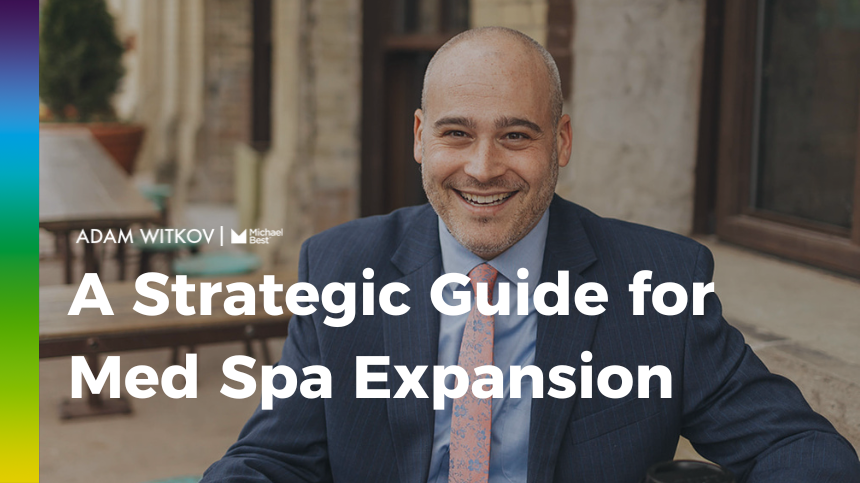The aesthetic medicine industry is experiencing unprecedented growth, with medical spas representing one of the fastest-expanding segments in healthcare. For successful med spa owners, the natural progression often leads to expansion—opening additional locations, bringing on partners, or scaling operations to meet growing demand. However, what works at a single location doesn't automatically translate to multi-location success, especially when regulatory compliance and employment complexities multiply across state lines and jurisdictions.
Having worked with numerous aesthetic practices through various stages of growth, I’ve seen firsthand how legal strategy can either fuel smart expansion or create costly roadblocks. The difference often comes down to understanding that scaling a med spa isn’t just about replicating your business model—it’s about building legal infrastructure that can support sustainable growth while managing the unique risks inherent to the aesthetic medicine industry.
The Multi-Location Compliance Challenge
One of the biggest surprises for expanding med spa owners is discovering that regulatory compliance doesn't scale linearly. Each new location brings its own set of requirements, and what's perfectly compliant in Wisconsin might require significant modifications in Illinois or Iowa.
State-by-State Regulatory Variations
Medical spas operate at the intersection of healthcare regulation and consumer services, which creates complex compliance requirements that vary significantly by state. Some states require direct physician supervision for certain procedures, while others allow nurse practitioners greater autonomy. Licensing requirements for aestheticians and medical staff differ, and even the scope of services you can offer may change based on local regulations.
Federal Compliance Considerations
Multi-location operations also trigger additional federal compliance requirements. HIPAA compliance becomes more complex when patient information flows between locations. OSHA requirements may vary based on the procedures offered at each location. The key is building compliance systems that can adapt to different regulatory environments while maintaining consistent quality and safety standards across all locations.
Employment Law Complexities in Multi-Location Med Spas
Perhaps nowhere is the complexity of med spa expansion more apparent than in employment law. Medical spas typically employ a unique mix of medical professionals, licensed aestheticians, and customer service staff—each with different licensing requirements, supervision needs, and employment law protections.
Mixed Medical and Non-Medical Staff Challenges
Traditional employment law gets complicated when you have registered nurses working alongside aestheticians and front desk staff. Different states have varying requirements for supervision ratios, continuing education, and scope of practice limitations. What's more, employee classification can become murky when aestheticians perform some medical-adjacent services under physician supervision.
Multi-State Employment Compliance
When your expansion crosses state lines, employment law compliance becomes exponentially more complex. Different states have varying requirements for:
- Employee break and meal periods
- Overtime calculations and exemptions
- Commission and tip pooling regulations
- Non-compete and non-disclosure agreement enforceability
- Required employee benefits and leave policies
Professional Licensing Across Jurisdictions
Medical staff and aestheticians must be properly licensed in each state where they practice. But what happens when you want to have your California medical director provide oversight for a Wisconsin location? Or when you want to transfer a highly skilled aesthetician between locations? These scenarios require careful planning around licensing reciprocity, supervision requirements, and scope of practice limitations.

Partnership and Ownership Structures for Scaling
Many med spa owners find that expansion requires bringing on partners—whether for capital, expertise, or local market knowledge. However, the unique regulatory environment of medical spas creates specific challenges around partnership structures and ownership arrangements.
Medical Practice Acts and Ownership Restrictions
Some states have restrictions on who can own medical practices, which directly impacts how you structure med spa ownership. In some states, only licensed physicians can own medical practices, while others allow broader ownership structures. These restrictions can significantly impact your ability to bring on investors or business partners who aren't licensed medical professionals.
Investment and Financing Structures
Traditional business financing often doesn't account for the regulatory complexities of medical practices. Lenders and investors need to understand that med spa cash flow can be impacted by regulatory changes, and that expansion requires more than just capital—it requires ongoing compliance investment. Private equity investment in medical spas has grown significantly, but these arrangements require careful structuring to maintain regulatory compliance while achieving investor objectives. Corporate practice of medicine laws, fee-splitting restrictions, and professional liability considerations all impact how you can structure investment relationships.
Succession and Exit Planning
As your med spa grows, succession planning becomes increasingly complex. Unlike traditional retail or service businesses, medical practices have specific requirements around ownership transfer, patient record management, and continuation of care. Planning for these contingencies early in your expansion process protects both your investment and your patients' interests.
Risk Management for Rapid Expansion
The aesthetic medicine industry's rapid growth has attracted increased regulatory scrutiny and litigation risk. Expanding operations amplifies these risks, making comprehensive risk management essential for sustainable growth.
Professional Liability and Insurance Considerations
Each new location multiplies your professional liability exposure. Different procedures carry different risk profiles, and your insurance coverage needs to reflect the specific services offered at each location. Moreover, some states have different requirements for professional liability coverage minimums. Beyond professional liability, multi-location operations create additional risk exposures around premises liability, employment practices liability, and cyber security. Your risk management strategy needs to account for how these exposures compound across locations while ensuring consistent quality standards.
Patient Safety and Quality Control
Maintaining consistent patient safety standards across multiple locations requires systematic approaches to training, supervision, and quality control. This isn't just about good business practice—it's about liability management and regulatory compliance.
Building Legal Infrastructure for Sustainable Growth
Successful med spa expansion requires thinking beyond your current operations to build legal infrastructure that can support your growth objectives while adapting to changing regulatory environments.
Standardized Operating Procedures
Developing standardized operating procedures that can adapt to different regulatory environments is crucial for multi-location success. These procedures need to address not just medical protocols, but employment practices, compliance monitoring, and risk management across all locations.
Regulatory Monitoring Systems
The aesthetic medicine industry is subject to evolving regulations at federal, state, and local levels. Multi-location operations need systems for monitoring regulatory changes across all jurisdictions and implementing necessary adjustments to maintain compliance.

Strategic Questions for Med Spa Expansion
Before pursuing expansion, successful med spa owners should consider several strategic questions:
Regulatory Readiness: Do you understand the specific regulatory requirements in your target markets, and do you have systems in place to maintain compliance across multiple jurisdictions?
Operational Scalability: Can your current business model adapt to different regulatory environments while maintaining quality and profitability?
Management Infrastructure: Do you have management systems and personnel capable of overseeing multi-location operations while ensuring consistent compliance and quality standards?
Financial Resources: Have you budgeted for the ongoing compliance costs and legal infrastructure required for multi-location operations?
Risk Tolerance: Are you prepared for the increased liability exposure and regulatory scrutiny that comes with expansion?
The Strategic Advantage of Proactive Legal Planning
The most successful med spa expansions I've been involved with share a common characteristic: they invested in legal strategy before making expansion commitments. Rather than treating legal compliance as a hurdle to overcome, these owners recognized that smart legal planning could actually accelerate their growth while protecting their investments.
Proactive legal planning for med spa expansion typically includes:
- Comprehensive regulatory analysis of target markets
- Employment law compliance audits and policy development
- Partnership and ownership structure optimization
- Risk management and insurance planning
- Technology and data security compliance
- Standardized operating procedure development
This approach often reveals opportunities for competitive advantage—ways to structure operations that not only satisfy regulatory requirements but also improve operational efficiency and patient experience.
Making Intentional Expansion Decisions
The aesthetic medicine industry will continue to grow, and well-positioned med spas have tremendous expansion opportunities. However, scaling a med spa successfully requires more than business acumen and capital—it requires legal strategy that accounts for the unique regulatory environment and risk profile of aesthetic medicine.
The difference between expansion that fuels long-term success and expansion that creates costly problems often comes down to understanding the legal landscape before making commitments. By building legal infrastructure that can support your growth objectives while managing regulatory compliance and risk exposure, you position your med spa for sustainable expansion rather than costly course corrections.
Your expansion plans deserve the same strategic attention you give to your clinical protocols and customer experience. The investment in proper legal planning doesn't just protect against downside risk—it often reveals opportunities for competitive advantage and operational efficiency that can accelerate your growth trajectory.
Scaling your aesthetic practice requires more than business vision—it requires legal strategy. Let's discuss how to expand intelligently.
Every med spa expansion presents unique challenges and opportunities. If you're considering growth beyond your current location, I'd welcome the opportunity to discuss how strategic legal planning can support your expansion objectives while protecting your investment. Understanding the regulatory landscape and building appropriate legal infrastructure before making expansion commitments often reveals opportunities for competitive advantage while avoiding costly compliance issues down the road.



/Passle/5f6edd8e8cb62a0bec3e5fd2/SearchServiceImages/2025-09-11-17-02-51-670-68c300bb2b4d83f984228268.jpg)
/Passle/5f6edd8e8cb62a0bec3e5fd2/SearchServiceImages/2025-12-09-17-26-29-785-69385bc51b6076d9d89a0c1d.jpg)
/Passle/5f6edd8e8cb62a0bec3e5fd2/SearchServiceImages/2025-11-03-17-23-19-226-6908e5071f19d47f0059f1f9.jpg)
/Passle/5f6edd8e8cb62a0bec3e5fd2/SearchServiceImages/2025-11-03-17-13-39-241-6908e2c36964a8f1db8d29cc.jpg)